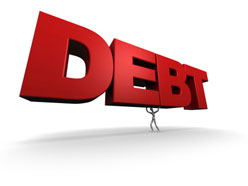
Canadians are buried under a heap of consumer debt which exceeds $477 billion, says Statistics Canada. Not surprisingly, the number of bankruptcies is ticking higher.
And if you think that’s bad, wait until the economy picks up steam and interest rates start to mount. The damage, say experts, is done and is irreversible.
The best Canadians can do now is stop spending money they don’t have, says Michael Carson, managing partner of Ottawa-based Surgeson Carson Associates Inc., which is part of the Personal Bankruptcy Canada network.
Read: Consumer debt up, defaults down
“Getting credit these days is like getting free money [so] people don’t think about repaying debt and the cost of repayment,” he says. “They’re getting million-dollar homes at historic low mortgage rates. But what happens when rates rise, effectively doubling your monthly payments?”
Stress testing, he says, can help determine the scope of the problem. Even in an unlikely scenario if consumer debt levels remain where they are and interest rates go from 3% to 4%, that’s a 33% increase.
“Do the math,” says Carson. “My concern is there’s a [debt] bubble waiting to burst. That potentially puts us into a dramatic tailspin.”
There’s no effective way to control consumer spending, or their abilities to pay. And when the two collide, the debt bomb detonates.
Read: How to borrow smartly
Experts like David Smith, president of Personal Bankruptcy Canada, put it down to Canadians “losing their cognitive connection to cash.”
The latest data from the Canadian Bankers Association shows a staggering $301 billion was charged to over 74 million VISA and MasterCard credit cards in Canada. This far surpasses the $606 million in cash withdrawals from bank machines during the same period.
“Before, you either had cash or you didn’t,” says Smith. “Plastic payment methods allow, and even encourage, people to spend absent mindedly because they have no tangible reminders of how much they are spending and when they spend more than they earn.”
Read: Canadians struggling with debt
According to the Office of the Superintendent of Bankruptcy (OSB), insolvencies in Canada had a 20.9% jump in January.
Smith blames aggressive marketing tactics by credit card companies and banks that promote plastic money, creating an endless cycle of debt.
“Each time [consumers] use their cards they are taking out a high interest, unsecured loan and it’s costing many people thousands of dollars in interest,” he says. “Credit card debt is the single most common type of debt burdening those who wind up in bankruptcy.”
The Bank of Canada and personal finance pundits have long been warning Canadians about burgeoning household debt relative to disposable income.
Read: Wealthy clients have debt, too
The solution, says Carson, lies with no one else but consumers themselves.
“It’s about lowering expectations,” says Carson. “We are a fairly free-spending society. Look at the malls — people are spending money like it’s going out of fashion. The only thing that can stop it is if [interest] rates start to go up.”
Financial experts can play a key role in helping clients face reality, he adds.
“When people get calls and default notices from their creditors, that’s the time they need some serious advice,” he says. “[These experts can determine if] we’re looking to expunge the debt or [if we’re] looking at something as serious as bankruptcy.”